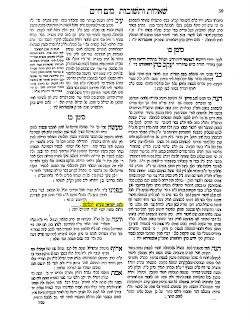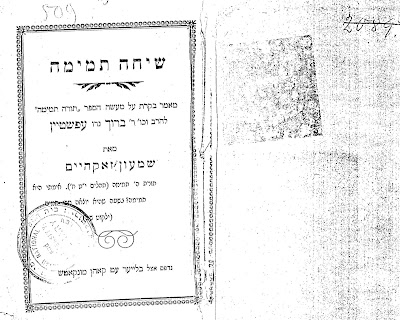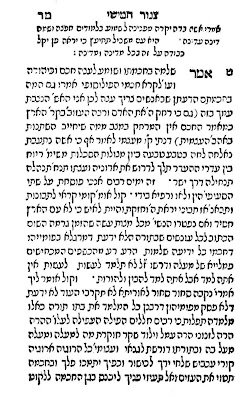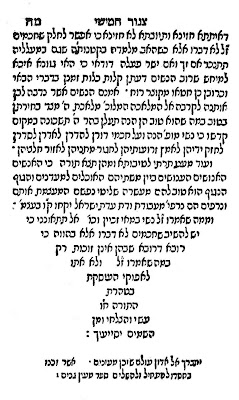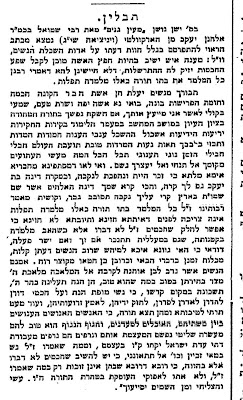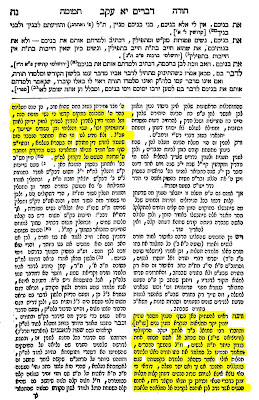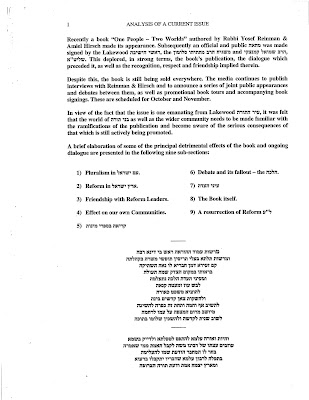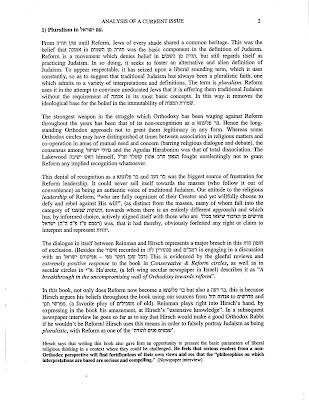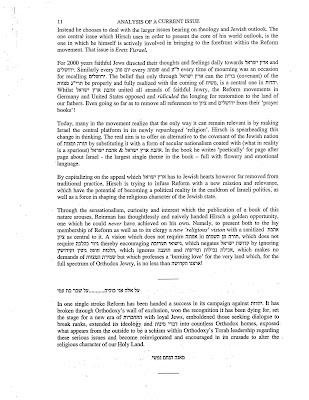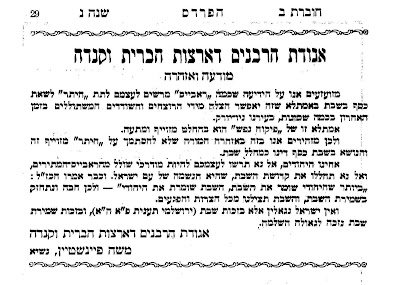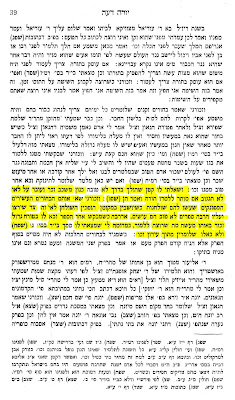Lag Ba-Omer and Upsherins in Recent Jewish literature: Revisionist History and Borrowing and Plagiarism
By Eliezer Brodt
By way of introduction, in the past few years, the field minhaghim, specifically the research and investigation of sources and reasons for custom has expanded exponentially. To be sure, from early rishonim and onwards we have many books discussing minhag. But, only more only more recently, did the systematic study and collecting of sources as they relate to minhag really start. The basic idea underlying this particular area of research involves digging up as many sources as one could related to a particular minhag and then to try and put together a comprehensive picture of the development of the specific minhag. This is a time consuming process. To begin with, one has to carefully track down early sources, figure out who is earliest source, and then try to understand the reasons given for the custom on the whole. Additionally, one has to be mindful of who influenced whom, separate the development from the original unadulterated custom, as customs, being the product of human development tend to themselves to develop over time. The older a minhag is, the more difficult a challenge as the possible source texts multiply and patience is required to put together the whole puzzle.
The recent interest in the field has produced many articles and books. Although many of these articles rely on one another, proper attribution varies widely. Some authors always give credit, while others just “borrow” sources and still others take entire text portions without any attribution. At times, to obscure this misappropriation, the order of the original article is changed although the text remains the same.
Bar-Ilan University professor Daniel Sperber, in the introduction to his eighth and final volume of his Minhagei Yisrael, catalogues and comments on many recent works minhag. In an earlier volume he published a bibliography on minhagim by Prof. Yosef Tabory.
The Moadim le-Simcha Series
In this genre, one of the more recent and popular books is Moadim le-Simcha, by R. Tuviah Freund. The sixth volume of this series has just been published. The volumes follow the yearly holiday cycle and this latest volume covers the holidays appearing in the months of Iyyar and Sivan.
R. Freund first publishes portions of the books in the newsweekly Hamodia (Hebrew). Then, he updates them and collects and arranges them according to the months. Overall, the material found in this collection is excellent. R. Freund uses a wide range of sources and it is obvious that he works hard to put out a good product. Moreover, just collecting this disparate material in one place is admirable.
But, aside from doing his own research – a task that is obviously quite time consuming – R. Freund employs two other methods that ultimately allow him to produce these books. As I have elaborated on in the past, Machon Otzar ha-Poskim has a card catalogue comprising thousands of topics with a phenomenal amount of sources related to those topics. R. Freund, as other contemporary authors, uses these cards to get a head start (alternatively, sometimes the cards provide everything) on the articles in Moadim le-Simcha. R. Freund freely acknowledges, at the beginning of each volume, that he relies on these cards.
As we have previously noted, another source of R. Freund’s materials, however, goes unacknowledged. On many topics, not necessarily all, he locates a key article of a talmid hakham or academic scholar, and then R. Freund proceeds to use their material. At times he mentions the original source in a random footnote while on other occasions he makes no mention at all.
Of course, there is no problem using someone else material so long as the source is clearly noted at the outset of the chapter that you used it and you are adding on your own finds. To be sure R. Freund is not the only who fails to properly note all of his sources; many authors do this today both in the traditional rabbinic and academic communities, and this is not a new phenomenon. Indeed, below, we will see another such example.
Setting aside this methodological issue, Moadim le-Simcha also suffers from lack of proper organization. Chapters do not flow into one another like they should, content is not put in chronological order and many times sources are not given. One other issue is one can always find more material touching on the topics covered in Moadim le-Simcha. Although this is not a criticism of R. Freund but is an issue anytime someone attempts to collect material on minhagim. Overall, however, Moadim le-Simcha is well worth one’s money as it does have a wealth of information some of which will not be found else where on many interesting topics relating to the months of the year.
Moadim le-Simcha, volume 6 – The Customs relating to the Months of Iyyar & Sivan
As mentioned above, the latest volume of this series covers Iyar and Sivan. The first article is a lengthy one covering the issues of becoming bar-mitvah during the sefirah period. This one section is over ninety pages. The next topic is Pesach Sheni. The next eight articles cover topic that are connected with Lag Ba-Omer. The final section covers Shavous topics.
It is the Lag Ba-Omer section, however, that will be the focus of our discussion. Topics covered include the recent minhag called ח”י רוטל (pp. 146- 148), bows and arrows on Lag Ba-Omer (pp. 155-58),[1] and the origins of bonfires on Lag Ba-Omer and burning clothing. There is then a detour to discuss the more general custom of lighting candles at graves year-round. Then we return to Lag Ba-Omer with a discussion of Upsherin and a section on peyos, after which he discusses the custom of learning at the kever of the Rabbi Shimon bar Yochai (“Rashbi”), followed by a chapter on the halakhic discussions relating to Kupas (charity) of Rashbi. On the topic of Rashbi, R. Freund turns to the controversial topic of authorship of the Zohar, as well as some general aspects of studying Kabbalah. Then we have another detour to discuss visiting graves of Tzadkim in general. He concludes this section with a discussion of the minhag to go to the kever of Shmauel ha-Navi on the forty-third day of Sefirat ha-Omer.
We now turn to the content of these chapters and Lag Ba-Omer generally.
Traditionally, the sefirah period is considered a time of mourning. The most well-known reason given – offered by the rishonim – is the mourning is due to the death of students of R. Akiva who died during this time of the year. Because this is deemed a mourning period, we refrain from shaving, taking haircuts, dancing, listening to music and making weddings, etc. Interestingly, some seem to think that there is an additional minhag during this time of abstaining from purchasing new clothes in order to avoid making a shehecheyanu; however, this is wrong. Many poskim write that people erroneously confuse the sefirah period restrictions with those customarily applied during the three weeks. Indeed, during the three weeks, one should refrain from buying new clothes to avoid a shehecheyanu, but during sefirah no such halakha applies. For example, the Mishnah Berurah writes that if during sefirah [493:2]:
The source for this ruling is the Ma’mar Mordechai who writes:
While this is the halakha, today we do know that in fact there is some bases for refraining from shehecheyanu during sefirah. As many manuscripts have come to light, one of these manuscripts reflects this customs. In fact, this topic was comprehensively covered by R. Gedaliah Oberlander in his journal Ohr Yisroel, and later reprinted in his collection on minhaghim called Minhag Avosenu be-Yadenu (Merkaz Halakhah, 2005). There is much to add on this topic and I hope to return to it in a future post at the Seforim blog. While on this topic of shehecheyanu during sefirah, it is worth noting that one of the earliest sources reflecting this custom is the Leket Yosher. R. Zilber, quoted by R. Ben David, in his article in Tzohar, uses this example to question the authenticity of the Leket Yosher. Basically, they argue the Leket Yosher must be a forgery as this custom is only attested to in recent times. But, as I mentioned R. Oberlander demonstrates that there are many sources for the shehecheyanu restriction aside from the Leket Yosher. (Also, R. Ben David, in a later issue of Tzohar admitted that the fact the Leket Yosher may confirm what was believed to be a later custom is meaningless and disavowed his reliance on R. Zilber.)
Prof. Daniel Sperber (Minhagei Yisrael 1:101-117) posits that the mourning customs during sefirah are mainly due to the crusades, as many of the most horrific events of the crusades took place during the sefirah period. As evidence, Sperber notes that in Ashkenaz there was a custom to refrain from cutting one’s nails – a terrific extension of symbolic mourning. Moreover, in Sefer Assufot [printed in a few places- see Meoros ha-Rishonim p. 89] it says:
In Spanish sources, however, we find that they were much more lenient some going so far to permit marriage during the sefirah period. (For one example of this leniency, see the manuscript published by Meir Benayahu,Yosef Bechiri [Jerusalem, 1991], 518-20).
Now for some reason or reasons all these prohibitions are lifted on Lag Ba-Omer. Additionally, there is a custom to celebrate on Lag Ba-Omer, while to a more limited degree in many places, but especially in Meron at the Kever of Rashbi. In Meron there are great celebrations with music and dancing and the like on Lag Ba-Omer. The obvious question, however, is why?
Now I will not even attempt to provide all the answers offered, but in a moment I will point the interest reader to additional sources. There are many early sources for simcha on Lag Ba-Omer, also that tachanun is omitted, marriages are allowed and so is shaving. In some rishonim the reason given is because the students of Rabbi Akiva stopped dying on Lag Ba-Omer. This reason, however, provides no insight into the connection between Meron and specifically Rashbi and Lag Ba-Omer.
One of the most famous reasons explaining the connection between Rashbi and Lag Ba-Omer – if you ask anyone this will probably be their reply – is because the Rashbi died on Lag Ba-Omer. Assuming for a moment this is factually correct, it is quite strange that we celebrate Rashbi’s death. We don’t find any other yahrzeit that we celebrate it in such a way and we had many other great people die besides for Rashbi, Avraham, Moshe, David HaMelech, etc. – none of whose death we celebrate with bonfires. Another problem is that neither chazal nor any of the rishonim mention Rashbi dying on Lag Ba-Omer. These questions and others were addressed by the Hatam Sofer in his teshuvot. In fact, because of these problems, he was very skeptical – to put it very mildly – of this celebration that takes place at Meron.
As an aside, an unknown sources about this whole topic is a statement found in some versions of Toledot Ha-Arizal (Sefer ha-Ari, 219) it is also found in a manuscript of the Chida which says:
With this introduction regarding Lag Ba-Omer, we can now turn to the Moadim le-Simcha’s discussion of Lag Ba-Omer customs.
He starts the topic of Lag Ba-Omer with a nice list of issues regarding Lag Ba-Omer giving the impression that this list indicates the progression of the articles. The reader is quickly disabused of this notion as R. Freund jumps from topic to topic at times returning to earlier topics with no discernable order. After carefully reading the Lag Ba-Omer section, I decided to compare R. Freund’s work with that of R. Betzalel Landau’s [author of ha-Goan mi-Vilna] on Lag Ba-Omer called מסע מירון. R. Landau’s sefer is a collection of articles printed in 1966 and as is the case with R. Freund, R. Landau’s articles also first appeared in the Hebrew weekly Hamodia. R. Landau’s work is printed along with the Maseh Meron of R. Mendel Rabin. R. Landau’s articles deal with everything connected to Lag Ba-Omer, from the visiting of Meron and the accompanying celebration to Upsherin and much more. It is written beautifully, well organized and has excellent sources including manuscripts and many rare seforim.
After comparing the material, I noticed that R. Tuviah Freund basically lifted all the material from R. Betzalel Landau with one big difference: where R. Landau presents the material in very organized fashion, R. Freund does not. To be sure, Freund adds much material to the topics discussed by Landau and Freund covers areas not covered by Landau. On the other hand, Freund omits many interesting topics and sources relating to this day that he should have dealt with such as discussion of the song Bar-Yochai.[2] The point is not that Freund used the sources collected by Landau but rather at the outset of the articles Freund should note his debt to Landau and reference the reader to Landau’s work for its additional materials. In fact, in passing on at least two occasions Freund mentions “Mase Meron” indicating that indeed he was aware of and used Landau’s work. To make this even more bizarre, the only times Freund cites Landau, in truth, Landau was merely quoting from Avraham Yaari, Iggerot Eretz Yisrael (Tel Aviv, 1943), a work that Freund uses directly in other places (379-384). In other words, the times he does mention Landau’s work it was almost unnecessary while where Freund should mention it he does not. Is it to say that only here he used Landau work and the rest he found himself? I find it hard to believe and quite silly – there is no problem to use someone else’s material as long as you give them proper credit.
A Revisionist History of Lag Ba-Omer and Another Example of Plagiarism.
Before returning to the rest of R. Tuviah Freund’s Moadim le-Simcha, we need to examine another recent article that appeared in the journal Yeshurun (no. 15) authored by R. Moshe Blau. R. Blau’s article is devoted to Lag Ba-Omer and is well organized and clearly written – a model for R. Freund to learn from. While these facts distinguish R. Blau’s article from Freund’s, Blau actually has something in common with Freund – Blau too plagiarized.
Again, Blau uses information that appears elsewhere without mentioning the sources. Specifically, Blau plagiarized from Avraham Yaari, Meir Benayahu, Betzalel Landau, and possibly even R. Yaakov Hillel, as I will demonstrate below.
As I mentioned earlier many traditionally many claim the yarzheit of Rashbi is on Lag Ba-Omer. While this claim is well-known the source of this tradition is more difficult to locate. Avraham Yaari and Meir Benayahu show that the earliest source to mention Lag Ba-Omer as the yarzheit of Rashbi is none other than the Hemdat Ha-Yamim. (R. Yaakov Hillel also confirms this on page 13 in his Aid ha-Gal ha-Zeh.)
There were some, however, who attributed the Lag Ba-Omer death date of Rashbi not to Hemdat Ha-Yamim but to R. Hayyim Vital, whose source was the Arizal. In truth, it is a mistake to give R. Vital credit for this. The source of this mistake was based on a simple printing mistake in one version of the Prei Etz Chaim which was first printed in 1782 – available here. (For more on this edition see R. Yosef Avivi, Binyan Ariel, pp. 68-71.) That edition reads:
The Chida already writes that this is a mistake and instead of שמת, one letter is missing and the correct reading is שמחת רשב”י. So it is not a reference to Rashbi’s death day at all. Avraham Yaari demonstrates that other sources aside from the Prei Etz Chaim confirm this reading of שמחת. Meir Benayahu also concludes this is the correct reading using manuscripts. Finally, R. Yakov Hillel also writes that it is clear from viewing many manuscripts of the Prei Etz Chaim that it is a mistake. [3]
Turning to the origins of going to Meron, again, Avraham Yaari, in an article in Tarbiz 22 (1951) has a very detailed piece showing how the custom of going to Meron was taken from an earlier custom of going on Pesach Shnei to the kevarim of Hillel and Shamai in Meron. Soon after Yaari published this article, Meir Benayahu penned a strong rebuttal (Sefunot 6 pp. 11-40), and is again summarized in Sefer Vilnai 2:326-330). According to Benayahu, the custom of going to Meron was begun by the “Mekubeli Sefat.” Irrespective of whose side one falls, both articles are full of interesting facts about the development of this Lag Ba-Omer. In my opinion, Benayahu appears to have the upper hand. More recently, Tel Aviv University professor Elchanan Reiner revisited this topic in his incredible dissertation, “Pilgrims and Pilgrimage to Eretz Yisrael (1099-1517),” (PhD dissertation, Hebrew University of Jerusalem, 1988), 295-320. (Hopefully, Dr. Reiner will publish this in book form.)
Returning to Freund’s article on Lag Ba-Omer, there is no doubt he used both Landau and Benayahu, as he quotes them in his notes. At the end of his article, Freund raises the older, although less known, custom of going to the grave of Shmuel ha-Navi (again close to Lag Ba-Omer) (p. 384). In doing so Freund quotes an early source for this custom, a source that is only in manuscript. But, Freund provides no citation where this source can be found. In fact this comes from Yaari (neither Landau or Benayahu mention it) who notes that this was originally published in Jacob Moses Toledano, “Teudot mikkitvey-yad,” Hebrew Union College Annual 4 (1927): 449-466, quote at 458. So either Freund was perusing random old copies of HUCA or more likely, he found Yaari’s article on Lag Ba-Omer and neglected to mention that.
Coming back to Blau’s article, the general idea of Blau in his article is after dealing with all the sources of why Lag Ba-Omer is different than the rest of Sefirat ha-Omer. His new ideas which he brings to the table are that 1) the earliest source for Lag Ba-Omer being the death of Rashbi is from Hemdat ha-Yamim. This point was already made by both Yaari and Benayahu. 2) The printings of Prei Etz Chaim contains a printing error (Blau shows this to be the case from various manuscripts he checked). Again, not a new point, while it is nice that he prints in the article copies of the various manuscripts but this also was already shown to be the case by Benayahu much earlier. 3) Finally, at the end of his article he brings from a manuscript that R. Yosef Karo wanted to stop the going to Meron but did not. Blau, however, concludes that this fact is not mentioned by the Chida because the Chida did not believe this manuscript was legitimate. This whole major manuscript is brought by Yaari and Benayahu. The text itself is printed in Benayahu’s Sefer HaChida. Additionally, R. Landau also discusses this point. None of this is noted by Blau. All in all this leads to the conclusion that much of Blau’s article is premised, without attribution, on Yaari’s, Benayahu’s, and Landau’s works on the topic.
As an aside both R. Yaakov Hillel and R. Ovadiah Yosef (Yabia Omer 5:35 and Hazon Ovadiah, p. 274) do not encourage going to Meron on Lag Ba-Omer due to the situation of pritzus there. R. Hillel is also against going on these types of hilulas throughout the year.
In actuality, while it is difficult to connect with the death of Rashi, there is another important person who perhaps did die on Lag be-Omer, Yehoshua ben Nun. (See R. Hamberger, Shoreshei Minhag Ashkenaz 3:262). In Meglias Ta’anis, the last section, there is a part titled Meglias Ta’anis Batra. In many versions of this text, it places Yehoshua ben Nun’s death on Lag be-Omer. Professor Shulamis Elitzur, in her excellent book, Lamu Tzamnu, deal with the death date of Yehoshua ben Nun at length. She cites to many early piyutuim that mirror this reading found in Meglias Ta’anis. (See Lamu Tzamnu pp. 18, 26, 34, 39, 66, 120, 126, 172.) Generally, Lamu Tzamnu is a scientific edition of Megilas Tannit Batra. For further on this, see also her Piyyutei R. Pinchas ha-Kohen, pp. 240 & 693. See also, Landau, p. 71, who errs in this regard based on a faulty manuscript; S. Leiman, “The Scroll of Fasts: The Ninth of Tevet” in J.Q.R., vol. 74, pp. 174-95, esp. pp. 174-79; Reiner, op. cit., pp. 289-90.
Moadim le-Simcha on Upsherin and Peyos
Now that we have covered the two latest discussions of Lag Ba-Omer and their similar faults, we return to the rest of Moadim le-Simcha. Freund’s next major topic is that of Upsherin. The problem with this article is that it is not objective.
The source for the Upsherin custom is highly problematic. R. Benyamin Shlomo Hamberger, Shorshei Minhag Ashkenaz 3:251-267, attacks it for the following reasons: there is no mention of this custom in any of the rishonim. Now do not say they did not bother to write it down as we have very detailed discussions from the rishonim about this time period in a Jewish boy’s life how to take him to cheder etc. (discussed by R. Hamburger at great length in volume two of his Shorshei Minhag Ashkenaz 2:502-532) but there is no mention of the Upsherin custom.[4] Furthermore, he shows from many places in the times of the rishonim they cut their hair long before three years old. Another big question dealt with by Yaari and later on in more detail by Hamberger is the attributing the custom of Upsherin on Lag Ba-Omer to the Arizal. This attribution is problematic as it is documented that the Arizal did not cut hair the entire sefirah – including Lag Ba-Omer. This particular issue M. Benayahu does not find to be such a problem as it could be what he did to his son and what he himself did were two different things. Another issue R. Hamberger raises is even if there is such a minhag what does it have to do with Rashbi and where do we find such a thing to give a haircut in a grave yard? Further more he brings sources [amongst them a National Geographic Magazine!] which claim that it come from outside – Arabic influences. R. Hamburger does defend it a little that it still makes sense to keep if it comes from outside sources. However after seeing all this documentation of R Hamburger notes that it makes sense why we can not find sources in litvishe or Hungarian sources – as there are no early sources in rishonim!
Professor Sperber [Minhagei Yisrael 8: 13-30] takes Hamberger’s discussion much further documenting how this comes from many completely outside ancient sources. R. Yechiel Goldhaber (author of the Minhagei ha-Kehillos) told me that he just saw a manuscript of a letter of R. Akiva Yosef Schlesinger who writes very sharply that this whole custom is taken form outside sources. Generally, Freund has no problem mentioning R Hamburger as he quotes this very same volume in another chapter of his in this sefer – saying Tikun on shavuos night. But when it comes to using Hamberger to question or examine Upsherin, Freund seems unable to do so.
After this chapter Freund has a section all about the customs of peyos including different opinions about wearing it behind ones ears. A careful reading of this chapter shows he stole much [and he could of stolen even more] from Yitzchak (Eric) Zimmer’s chapter in his Olam Keminhago Noheg (Mercaz Zalman Shazar, 1996) devoted to these topics.
Freund continues with a chapter on the development of the tomb over Rashbi’s kever and its history. He has a lot of important information on it. I would add to it the last section of M Benayhu previously mentioned article (which I think for sure Freund was well aware of on this topic of Meron in general).
The Zohar and its History
In connection with Rashbi, Freund examines the Zohar, its authorship and other topics related to the learning of the Zohar. This topic really deserves its own series of posts but for now I will just point out three issues. He does not mention that there was any opposition to the authorship of the Zohar. Now I understand perfectly well why he does not mention Yehudah Aryeh (Leon) Modena and others but there is one work which definitely deserves mention and that is the Mitpachat Seforim from R. Yaakov (Jacob) Emden. This work is not an attempt to undermine Kabbalah at all but rather it shows that there was some tampering done to the Zohar by different people. To be sure this work was considered very important by many as the Hatam Sofer writes in a teshuvah [Choshen Mishpat Likutim, 59] to someone:
Interestingly enough a few years back this sefer was printed by someone than it was put in cherem by the badatz! The printer was cursed by sefardi mekubalim and he died within the year! This edition of the sefer is now considered very rare. Indeed, included in the introduction to this edition, are other sources attesting to the importance of the Mitpachat Seforim. Additionally, R. Eliezer Waldenberg, in his Tzizt Eliezer cites the Mitpachat Seforim. (Tzitz Eliezer 9:51 and 21:5).
Another issue I have with this chapter is he does not even mention the famous discussion of the poskim regarding contradictions between Kabbalah and halakha; much has been written on this I will not even bother to cite sources.
One other issue with this chapter is at the end he lists commentaries on the Zohar although he does not claim to make a comprehensive list there are some strange omissions. One is the work of R. Reuven Margoliyot on the Zohar it is extremely important with all his comments as he draws parallels from all over chazal another thing he does is he references many halakhic discussions from the Zohar. Besides for this R. Margoliyot deals with all the questions which R Emden raises in his Mitpachat Seforim. R. Shlomo Zevin, Soferim ve-Seforim, has a beautiful review of R. Margoliyot’s work. One other important work that is not listed is Tiferet Zvi from R. Spielman. Thus far it is only six volumes, going up until chumash Vayikra. This work is literally an encyclopedia on the Zohar dealing with the hundreds of halakha and kabbalistic topics relating to the Zohar [see the comment of Professor Yisrael M. Ta-Shma, ha-Niglah she-b’Nistar, 109 n. 13]. It is very ironic that during R. Spielman lifetime he had to peddle his seforim going door to door begging people to buy them and now it is a very hard to find to purchase.
Finally, Freund discusses visiting kevarim in general – he includes a special section about Kohanim. Here Freund writes openly at the outset that he used an earlier work but he should have been aware there is a much more through and important work on the topic from R Spielman called Zion Lenefesh Chayah.
General sources:
All about Lag Ba-Omer (much of the material overlaps) see R. Shlomo J. Zevin, Moadim Bahalcha pp. 359-64; S Ashkenazi in Avnei Chain pp. 103-11; Pardes Eliezer.
For personal accounts of Lag Ba-Omer see Chanina Mizrachi Yehudei Paras (Tel Aviv, 1959), 29-34. For a Christian traveler account from 1838 see Maseh ha-Notzrim, 496 see id., 517-18 for another account.
Others used to go to Kever of Shimon Hazadik see: Nachlas Yosef [2: 42]; Eiyur Hakodesh ve-Yoshveha p. 43. See a Christian traveler account from 1838 in Maseh ha-Notzrim p. 448 – he mentions that they cut the hair there.
On going to Meron in general see: Kivrei Avos pp. 179-81; The excellent collection from Z Vilani in his Mazavos be-Eretz ha-Kodesh pp. 117-150.
On Shmuel ha-Navi and visiting his grave, see Lamu Tzamu pp. 177-180; Reiner op. cit. pp. 306-320
Notes:
[1] On using bow and arrows on Lag Ba-Omer: see the sources listed by Landau, ibid pp. 124-26 [At this point I am unable to find the source for the riddle of the Malbim that Landau brings.] Moadim le-Simcha pp. 155-59; Pardes Eliezer pp. 229-49; ha-Koton ve-Halachosov chapter 24 p. 59 n. 22; Kundes p. 49 [see here on this work]; Zikhronot Av u-Beno p. 231; Zikhronot me-Rav Litai p. 245 [on this work see here]; A.S. Sachs, Worlds that Passed (Philadelphia, 1928), 112.
[2] About the song Bar-Yochai (which he choose not to talk about it at all), see Landau piece in Maseh Meron; the excellent study by Professor Moshe Hallamish, in Hakabblah, 507-531. See also Hallamish’s Hanageios Kabbalios be-Shabbat pp. 300-03. On general songs composed for Rashbi see Hallamish in Hakabblah pp. 259-83.
[3] R. Yaakov Hillel deals with all this in his sefer Aid ha-Gal ha-Zeh printed two years ago. This is a nice sefer all about Lag Ba-Omer and the Zohar. He has many interesting chapters including the origins of the Zohar the importance of learning Zohar and how to learn it. Another chapter he has is on the topic of contradictions between Kabbalah and halakha. He also has a chapter on Torah Lav Min hashamaayim and its relation to pesak halakha. He also deals with this topic in a few other places in his notes on Moreh Betzbah of the Chidah. It is worth seeing the latest edition, page 159 and onwards, as it is updated from the 1980 edition. He also dealt with this in his journal Mekabtzeal (25: 45-59). R. Hillel definitely saw what Benayahu writes on the topic but he does not credit him at all.
[4] For more on this see Ivan Marcus in Rituals of Childhood (Yale, 1996) and in his Jewish Lifecycle (Washington, 2004).






